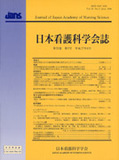Japanese
English
- 販売していません
- Abstract 文献概要
- 参考文献 Reference
- サイト内被引用 Cited by
要旨
本研究の目的は, ホスピス外来通院中の, 医学的に根治が困難と診断されたがん患者とともに生きる家族の体験の意味を, 家族の体験の記述を通して明らかにすることである. ホスピス外来通院中の患者の家族に非構成面接を行い, 得られたデータを現象学的アプローチを参考に質的記述的に分析した. 類型化により, 以下の結果が明らかになつた.
ホスピス外来に通院するがん患者の家族は, 患者の病気がもたらした生活の変化に当惑しながら, 病気の症状に太刀打ちできない自らの無力感を抱いており,けられない運命への問いに対して答えを模索していた. また家族は, 患者の病状の急激な悪化に伴い自己判断しなければならないことへの困難性を痛感していた. 将来に見通しのつかない看病をする日々は, 家族に患者との関係性から生じる葛藤と自責の念をもたらすものであつたが, 患者の症状の変化から患者と共に過ごす時間の有限性を悟るとともに, 支えとなつているものの存在を感じることは, 患者を看病し看取るという果たすべき役割を自覚させるものであつた. 同時に, 食の意味は家族にとつて, 患者の命を長らえるものと食べさせる喜びを与えるものとして重要性を増していた. さらに家族は患者とともに生きる時の中で, 患者の看取りを引き受ける覚悟をしはじめていた.
Abstract
The purpose of this study was to describe what families experience and how they discover the meaning of life when a member with a poor prognosis is treated a hospice outpatient clinic. Each of the families participated in unstructured interviews and all data were analyzed by the qualitative method based on a phenomenological approach. The following results were obtained by typology. Hospice outpatient families experienced confusion at the changes the patient's illness brought to their lives and felt limited in their ability to help the sufferer. Faced with an unavoidable fate, they could only grope for answers to their questions. Moreover, the decisions and judgments the families had to make as a result of the rapid worsening of the illness caused them intense difficulties. The need for daily care for a patient with no hope for the future brought about conflict and remorse in the family-patient relationship. However, the changes in the patient's condition made the family aware that time together was running out, and this fostered an awareness of their role in the patient's terminal care. Simultaneously, for the family, meaning of meals for the patient increased in importance, adding a sense of joy in feeding and helping to prolong his or her life. In addition, in the midst of their time together came the realization that the patient's terminal care would fall to them.
Copyright © 2005, Japan Academy of Nursing Science. All rights reserved.


